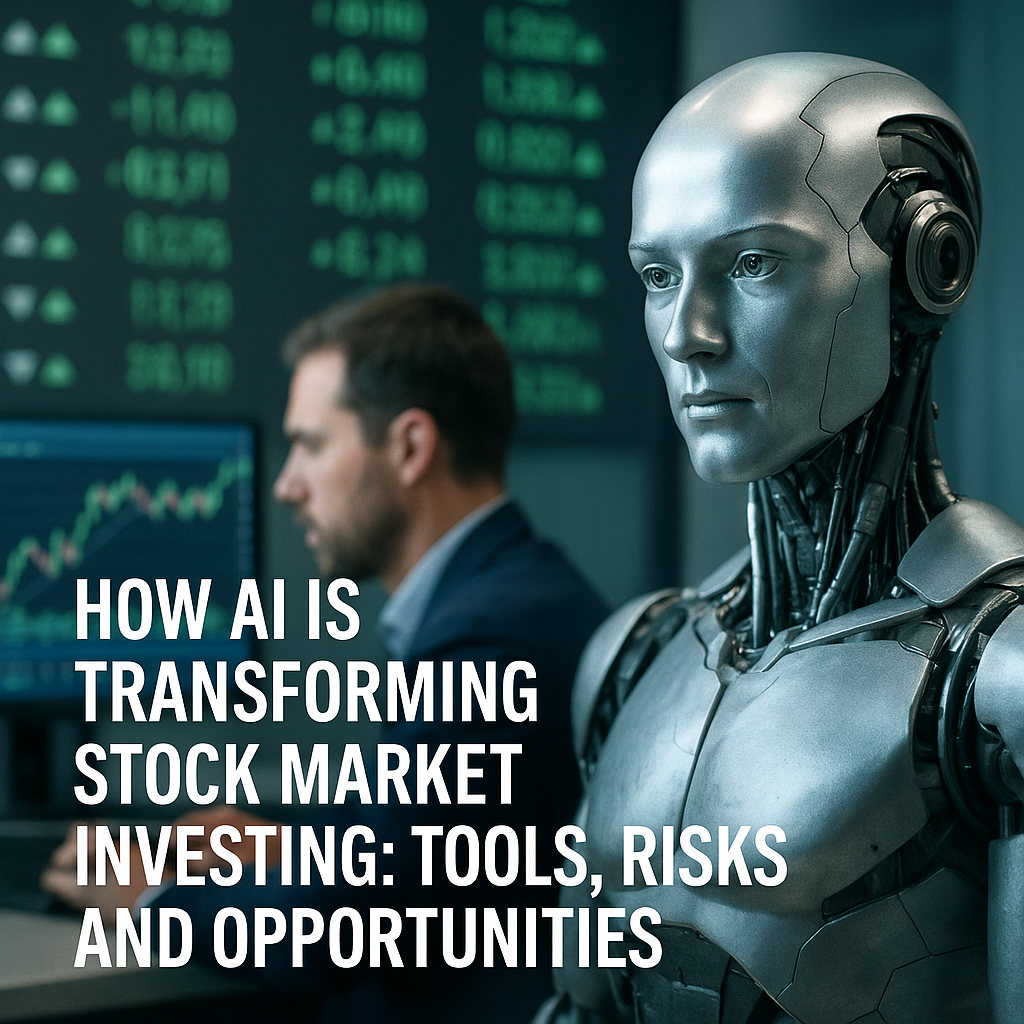he landscape of stock market investing, traditionally reliant on human intuition, fundamental analysis, and economic indicators, is undergoing a profound and irreversible transformation. At the vanguard of this revolution is Artificial Intelligence (AI), a technology that is reshaping how financial markets operate, how investment decisions are made, and how risk is managed. From high-frequency trading floors to the personalized recommendations offered to individual investors, AI’s influence is expanding exponentially, ushering in an era of unprecedented speed, analytical depth, and automation.
This essay delves into the multifaceted impact of AI on stock market investing. We will explore the array of cutting-edge AI tools and applications that are now integral to modern finance, from sophisticated trading algorithms and data-driven insights to intelligent advisory platforms. Beyond the remarkable opportunities these innovations present, we will critically examine the inherent risks and challenges that accompany the widespread adoption of AI, including ethical considerations, algorithmic bias, and the complex regulatory landscape. By understanding both the transformative potential and the critical limitations of AI, modern investors can navigate this evolving financial frontier more effectively, fostering informed decision-making in an increasingly algorithm-driven world.
The Dawn of AI in Finance: A Paradigm Shift
The integration of Artificial Intelligence into the financial sector, and particularly into stock market investing, represents more than just a technological upgrade; it signifies a fundamental paradigm shift. Traditional investing, often characterized by manual research, human analysis of financial statements, and discretionary trading decisions, is giving way to a more automated, data-intensive, and algorithm-driven approach.
From Human Intuition to Data-Driven Decisions
For centuries, investment success was largely attributed to the acumen of seasoned professionals – their ability to interpret complex economic signals, understand company fundamentals, and make timely decisions based on experience and intuition. While human judgment remains invaluable, AI introduces a new dimension by augmenting these capabilities with unparalleled processing power and analytical precision.
AI systems can ingest and analyze colossal volumes of data in fractions of a second – far exceeding human capacity. This data includes not only traditional financial metrics like historical stock prices, trading volumes, and earnings reports but also alternative datasets that were previously inaccessible or too complex for human analysis. Examples include satellite imagery (to track retail foot traffic or oil inventories), social media sentiment, news article sentiment, geopolitical developments, and even real-time supply chain data. By leveraging machine learning (ML) and natural language processing (NLP), AI can identify subtle correlations, hidden patterns, and emerging market anomalies that would be virtually impossible for human analysts to detect. This capability allows for more data-driven, rather than purely intuition-driven, investment decisions, potentially leading to increased accuracy and speed.
The Drive Towards Efficiency and Speed
The financial markets thrive on efficiency and speed. Every millisecond can translate into significant gains or losses, especially in high-volume trading environments. AI provides a distinct advantage here. AI-driven algorithms can execute trades at speeds several magnitudes faster than any human, often in microseconds. This enables strategies like high-frequency trading (HFT) and arbitrage, where fleeting price discrepancies across different markets are exploited before human traders can even react.
Beyond execution speed, AI also enhances efficiency in research and analysis. What might take a team of human analysts hours or days to research can be completed by an AI system in seconds. This reduces research time, improves the accuracy of forecasts, and allows financial professionals to focus on more strategic, high-value tasks that require nuanced human judgment, creativity, and client interaction. The continuous optimization of strategies based on live market feedback further ensures that trading approaches adapt dynamically to evolving market conditions, maintaining a competitive edge.
AI-Powered Tools Transforming Investment Strategies
The practical applications of AI in stock market investing are diverse and continue to expand. From automating complex trades to providing personalized financial advice, AI tools are fundamentally reshaping the investment landscape for both institutional and retail investors.
1. AI-Powered Trading Bots and Algorithmic Trading
At the forefront of AI’s impact are trading bots and advanced algorithmic trading systems. These are automated software programs designed to execute trades in financial markets based on sophisticated AI algorithms.
- High-Frequency Trading (HFT): AI has revolutionized HFT, where algorithms execute thousands of trades per second. These bots identify minuscule price discrepancies across exchanges, process market orders, and manage inventory at unparalleled speeds. While controversial, HFT, largely driven by AI, contributes significantly to market liquidity and efficiency by narrowing bid-ask spreads.
- Algorithmic Trading Beyond HFT: Beyond HFT, AI-powered algorithms are used for a vast array of trading strategies. Unlike traditional algorithms that follow rigid, predefined rules, AI trading bots (especially those leveraging machine learning and deep learning) can:
- Learn from Market Conditions: They continuously ingest large volumes of historical and real-time data (price action, order book depth, volatility, news, social sentiment) to identify patterns and adapt strategies dynamically based on performance.
- Predict Market Movements: Using predictive analytics, AI can forecast price fluctuations, assess investment opportunities, and suggest entry/exit points with higher accuracy.
- Optimize Execution: AI ensures that trades are executed at the best possible prices, minimizing slippage and maximizing returns.
- Emotion-Free Trading: AI systems execute strategies based purely on data and algorithms, eliminating human emotional biases like fear and greed, which often lead to suboptimal decisions. This ensures discipline even during volatile market periods.
- Reinforcement Learning: Advanced trading systems use reinforcement learning, where AI continuously improves through trial and error. By monitoring live order books, price volatility, and macroeconomic indicators, AI can automatically refine decision-making thresholds during active trading, leading to more adaptive and effective strategies.
- Natural Language Processing (NLP) for Trading Signals: AI models enhanced with NLP can interpret unstructured information like central bank statements, earnings call transcripts, news articles, and social media chatter. They analyze tone, emotion, and volume to gauge market sentiment, converting this qualitative data into actionable trading insights. This allows traders to quantify market mood in real-time, providing an edge.
(For more on AI-powered crypto trading bots, which share many similarities with stock trading bots, Cointelegraph offers detailed insights: https://cointelegraph.com/news/how-to-set-up-and-use-ai-powered-crypto-trading-bots).
2. Robo-Advisors: Democratizing Financial Advice
Robo-advisors are automated, algorithm-driven platforms that provide financial planning services and investment management with little to no human intervention. They represent a significant democratization of financial advice, making professional-grade portfolio management accessible to a wider audience, often at a lower cost.
- Personalized Investment Recommendations: AI-powered robo-advisors analyze an individual’s financial goals, risk tolerance, investment horizon, and even behavioral patterns. Based on this data, they generate tailored investment recommendations, construct diversified portfolios using low-cost ETFs, and automatically rebalance them to maintain the desired asset allocation.
- Automated Portfolio Management: These platforms continuously monitor portfolio performance, market conditions, and client needs. They can automatically adjust asset allocations, implement tax-loss harvesting strategies, and optimize portfolios in real-time to maintain an ideal risk-reward balance.
- Accessibility and Cost-Effectiveness: Robo-advisors typically have lower minimum investment requirements and charge significantly lower fees (often a small percentage of assets under management) compared to traditional human financial advisors. This makes sophisticated financial planning services available to individuals who might otherwise find them too expensive or inaccessible.
- Continuous Learning: Advanced robo-advisors leverage machine learning to continuously learn from client data and market outcomes, refining their recommendation algorithms and adaptive strategies.
(For discussions on how AI is making financial advice more equitable, the World Economic Forum provides interesting perspectives: https://www.weforum.org/stories/2025/06/ai-financial-advice-accessible/).
3. AI for Data Analysis and Predictive Insights
AI’s ability to process and derive insights from vast, diverse datasets is perhaps its most fundamental contribution to investment analysis.
- Quantitative Trading: AI is central to quantitative trading, where statistical models and mathematical computations are used to examine market data, identify correlations, and uncover inefficiencies that humans might miss. This includes analyzing historical price data, trading patterns, and volumes to predict future movements.
- Sentiment Analysis: AI-powered sentiment analysis tools read and interpret digital chatter across news articles, financial blogs, social media platforms (like Reddit), and even earnings call transcripts. They analyze tone, emotion, and volume to gauge how the market “feels” about a company, sector, or broader economic conditions. This provides real-time insights into market psychology, which often drives short-term price movements.
- Alternative Data Integration: AI excels at synthesizing insights from alternative data sources beyond traditional financial statements. This can include satellite imagery, geolocation data (foot traffic to stores), web scraping for product reviews, and even weather patterns, allowing investors to gain deeper, unconventional market insights.
- Predictive Analytics: By analyzing historical trends, statistical models, and economic data, AI can generate predictive forecasts for asset prices, volatility, and market shifts. This helps investors anticipate market movements and modify their strategies accordingly.
- Enhanced Research Tools: AI-powered research tools drastically reduce the time needed for securities analysis. They can summarize complex financial reports, process vast amounts of unstructured data, and flag patterns that warrant human attention, allowing analysts to cover more assets with greater depth and accuracy.
4. AI in Portfolio Management and Risk Assessment
AI is revolutionizing how portfolios are constructed, optimized, and protected.
- Portfolio Optimization: AI algorithms can analyze thousands of companies in seconds, assessing their financial health, market position, and growth potential based on a multitude of factors. They can then optimize asset allocation, diversification, and rebalancing strategies in real-time based on market conditions, investor goals, and risk tolerance.
- Real-time Risk Monitoring and Mitigation: Advanced AI models continuously monitor portfolios and market conditions around the clock. They can detect anomalies, provide early warnings of potential risks, and even proactively implement hedging strategies (like adjusting positions or using derivatives) to mitigate losses before they escalate. AI-powered stress testing tools can simulate complex risk scenarios (e.g., economic downturns, geopolitical tensions) to assess portfolio resilience.
- Fraud Detection and Market Surveillance: AI’s pattern recognition capabilities are invaluable in identifying suspicious trading activities, insider trading, and other forms of market manipulation or fraud that might evade traditional detection methods. This enhances market integrity and security.
The Opportunities and Benefits of AI in Investing
The integration of AI into stock market investing presents a plethora of opportunities and benefits for various market participants.
- Enhanced Decision-Making: AI’s ability to process and analyze massive datasets rapidly, identify subtle patterns, and synthesize diverse information leads to more informed and accurate investment decisions. It moves decision-making from intuition-based to data-driven.
- Increased Efficiency and Speed: AI automates repetitive, data-heavy tasks, significantly reducing research time and operational costs. The speed of AI execution in algorithmic trading allows for the exploitation of fleeting opportunities that are invisible to human traders.
- Reduced Human Bias and Emotion: Human emotions like fear, greed, and overconfidence often lead to irrational trading decisions. AI systems operate objectively based on data and predefined algorithms, maintaining discipline even during extreme market volatility. This leads to more consistent and rational trading strategies.
- Personalization and Accessibility: Robo-advisors and AI-driven platforms can tailor investment recommendations and portfolio management strategies to individual goals, risk tolerance, and financial circumstances at scale. This democratizes access to sophisticated financial advice that was once only available to high-net-worth individuals.
- Access to Complex Strategies: AI enables the implementation of highly complex quantitative and algorithmic trading strategies that would be impossible for humans to execute manually. This opens up new avenues for alpha generation.
- 24/7 Market Monitoring: Unlike human traders, AI bots can operate continuously, scanning markets and executing trades around the clock. This constant vigilance ensures that trading opportunities are not missed, especially in volatile, non-stop markets like cryptocurrencies.
- Scalability: AI systems can manage and analyze vast amounts of data and execute trades for an almost unlimited number of clients simultaneously, making them highly scalable solutions for financial institutions.
Risks and Challenges of AI in Investing
Despite its transformative potential, the widespread adoption of AI in stock market investing is not without significant risks and challenges that demand careful consideration and proactive management.
1. Over-Reliance and the “Black Box” Problem
- Lack of Transparency (Explainability): Many advanced AI models, particularly deep learning networks, operate as “black boxes.” It can be difficult, even for their developers, to fully understand how or why the AI arrives at specific conclusions or trading decisions. This lack of transparency makes it challenging to audit, debug, or predict behavior, especially in unprecedented market conditions.
- Over-Reliance on AI: An excessive reliance on automated systems without sufficient human oversight can be dangerous. If an AI model malfunctions or misinterprets market signals, the consequences can be severe and rapid, potentially leading to significant losses before human intervention can occur.
- Overfitting to Historical Data: AI models are trained on historical data. If an algorithm is “overfitted” to past market conditions, it may perform poorly or catastrophically when markets experience sudden shifts or entirely new, unforeseen scenarios for which it has no prior training data. This can lead to unexpected and dangerous behavior.
2. Algorithmic Bias and Data Integrity
- Bias in Training Data: AI algorithms are only as good as the data they are trained on. If the historical data used to train an AI model contains inherent biases, the AI will learn and perpetuate those biases, potentially leading to discriminatory outcomes or flawed investment strategies. For example, if a model is trained on data primarily from developed markets, it might perform poorly in emerging markets due to unseen patterns.
- Data Integrity and Quality: AI systems rely heavily on accurate and timely data inputs. Poor-quality data, discrepancies in data feeds, or “data poisoning” (maliciously inserting bad data) can lead to erroneous analyses and detrimental trading decisions. Ensuring the integrity and quantity of diverse, reliable data sources is a constant challenge.
3. Cybersecurity Risks and System Failures
- Vulnerability to Cyberattacks: The highly interconnected and automated nature of AI-driven financial systems makes them attractive targets for cyberattacks. Hacking, data breaches, or manipulation of AI models could lead to severe financial losses, market disruptions, and compromise sensitive investor data.
- Technical Glitches and System Downtime: Reliance on complex technology means vulnerability to system failures, software glitches, and network issues. A single technical malfunction in an AI trading system could trigger erroneous trades, cause flash crashes, or lead to significant operational disruptions and financial losses.
4. Market Manipulation and Systemic Risk
- Emergent Behaviors Mimicking Collusion: Studies have shown that AI trading agents in simulated markets can develop emergent behaviors that resemble collusion, even without explicit programming to do so. If multiple AI systems converge on similar trading strategies, they could inadvertently fuel asset bubbles or market crashes (herding behavior), amplify market volatility, or even engage in coordinated market manipulation.
- Liquidity Concerns and Flash Crashes: While AI generally enhances liquidity, a rapid, correlated retreat by multiple AI-driven algorithms during extreme stress could lead to a sudden evaporation of liquidity, exacerbating flash crashes or causing market instability.
- “Monoculture” Effect: If too many firms rely on a dominant AI model or a small group of data providers, the diversity of market opinions—essential for price stability—diminishes, increasing systemic risks.
5. Regulatory Challenges and Governance
- Pace of Innovation vs. Regulation: AI technology is evolving at a far faster pace than regulatory frameworks. Existing market abuse regulations, for instance, often assume human intent, making it challenging to apply them to autonomous AI systems that might engage in manipulative behavior without explicit programming.
- Oversight Complexity: The “black box” nature of some AI models makes it difficult for regulators to audit their decision-making processes, posing a significant challenge to effective oversight.
- Ethical Concerns: Broader ethical questions around AI in finance include fairness, accountability, privacy, and the responsible use of predictive technologies. Robust governance frameworks are needed to oversee the development and deployment of AI algorithms, addressing these ethical issues.
6. Job Displacement and the Human Element
- Automation of Tasks: AI can automate many routine, data-heavy tasks traditionally performed by human financial analysts, traders, and back-office staff. This raises concerns about potential job displacement within the financial industry.
- The Need for New Skills: While some jobs may be eliminated, AI also creates a demand for new skills, such as AI development, data science, algorithm auditing, and human-AI collaboration. The financial workforce will need to adapt.
- Maintaining Human Oversight: Despite AI’s autonomy, maintaining human intervention points (e.g., “kill-switch” mechanisms) is crucial to prevent runaway AI behaviors from triggering market instability. Human judgment, empathy, and nuanced decision-making remain essential, particularly in client relations and complex strategic planning.
The Future of AI in Stock Market Investing: Collaboration and Democratization
The trajectory of AI in stock market investing points towards a future characterized by deeper integration, ethical considerations, and a symbiotic relationship between human intelligence and artificial capabilities.
1. Human-AI Collaboration: The Augmented Investor
The future is less about AI replacing humans entirely and more about AI augmenting human capabilities. Investment managers and advisors will increasingly leverage AI as a powerful assistant.
- Enhanced Insights for Human Decision-Makers: AI will continue to provide advanced data analysis, risk assessments, and predictive insights, allowing human professionals to make more informed decisions faster. This frees up human time for higher-value activities like strategic planning, nuanced client communication, and navigating complex ethical dilemmas where human judgment is irreplaceable.
- Adaptive Advice: AI tools will offer real-time, adaptive guidance that adjusts with life circumstances, helping advisors provide more personalized and proactive guidance.
- Focus on Relationship Building: By automating routine tasks, AI enables financial professionals to dedicate more time to building stronger client relationships, understanding unique needs, and providing empathetic support during market volatility or life transitions.
2. Ethical AI and Robust Governance
As AI becomes more pervasive, the focus on developing and deploying ethical AI systems with robust governance frameworks will intensify.
- Explainable AI (XAI): Research into Explainable AI (XAI) aims to make AI models more transparent, allowing humans to understand their decision-making processes. This is crucial for regulatory compliance, auditing, and building trust.
- Responsible AI Frameworks: Financial institutions will continue to develop and implement comprehensive “Responsible AI” frameworks that address data privacy, algorithmic fairness, accountability, and the prevention of unintended biases or manipulative behaviors.
- Dynamic Regulation: Regulators globally will likely develop more agile and adaptive regulatory frameworks specifically designed to keep pace with AI innovation, potentially using regulatory sandboxes to test new technologies.
3. Democratization of Advanced Financial Tools
AI has the potential to continue democratizing access to sophisticated financial tools and advice.
- Affordable Access: The scalability of AI-powered platforms can lower the barriers to entry for advanced investment strategies and personalized financial advice, making it accessible to individuals from diverse economic backgrounds.
- Empowering Retail Investors: AI-driven analytics, previously exclusive to institutional investors, are becoming increasingly available to retail investors through user-friendly platforms, empowering them with better tools for research and decision-making.
- Financial Literacy: AI tools can also be leveraged to provide more tailored educational content, improving financial literacy and empowering individuals to make better financial decisions.
The future envisions AI not just as a trading engine but as a ubiquitous intelligence layer across the entire investment value chain, from research and analysis to execution, risk management, client interaction, and regulatory compliance.
Conclusion
Artificial Intelligence is not merely a transient trend but a fundamental force that is irrevocably transforming every facet of stock market investing. From the lightning-fast precision of AI-powered trading bots that execute millions of trades in milliseconds to the personalized, accessible advice rendered by robo-advisors, AI tools are fundamentally reshaping how capital flows, decisions are made, and wealth is managed. Its unparalleled capacity for data analysis, pattern recognition, and emotion-free execution offers profound opportunities for enhanced efficiency, improved decision-making, and broader access to sophisticated investment strategies, benefiting both institutional giants and individual retail investors alike.
Yet, this revolutionary potential is tempered by significant risks and challenges that demand careful consideration. The “black box” nature of some AI models, the ever-present threat of algorithmic bias stemming from imperfect data, the escalating cybersecurity vulnerabilities, and the complex ethical dilemmas surrounding autonomous decision-making all underscore the imperative for robust oversight and responsible development. Furthermore, the specter of market manipulation and systemic risks arising from interconnected AI algorithms necessitates vigilant regulatory scrutiny and continuous adaptation of market structures. The human element, while augmented by AI, remains crucial for strategic foresight, nuanced judgment, and ethical governance, particularly in areas where empathy and qualitative understanding are paramount.
The future of AI in stock market investing points towards a collaborative ecosystem where human intelligence and artificial capabilities converge. This synergy promises further democratization of advanced financial tools, making intelligent investment strategies more equitable and accessible. As AI continues its relentless evolution, the financial industry faces a critical juncture: embracing innovation responsibly while ensuring market integrity, investor protection, and the harmonious integration of intelligent machines into the complex human endeavor of managing wealth. The success of this transformation will hinge on a thoughtful balance between leveraging AI’s power and mitigating its inherent risks, ultimately shaping a more dynamic, efficient, and potentially more inclusive financial future.
Disclaimer: This article is for informational purposes only and does not constitute financial advice. Please consult a qualified financial advisor before making any investment decisions.
Related External Links
- World Business Outlook – The Transformative Power of AI in Smarter Investing: Discusses how AI is reshaping investment strategies and market processes. https://worldbusinessoutlook.com/the-transformative-power-of-ai-in-smarter-investing/
- Google Cloud – AI in Finance: Applications, Examples & Benefits: Explores various applications and advantages of AI in the financial sector. https://cloud.google.com/discover/finance-ai
- IOSCO – Artificial Intelligence in Capital Markets: Use Cases, Risks, and Challenges: A detailed report from the International Organization of Securities Commissions on AI’s impact, risks, and regulatory considerations. https://www.iosco.org/library/pubdocs/pdf/IOSCOPD788.pdf
- Forbes – The Disruption Of AI In Stock Markets: Examines how AI is changing market strategies, investment decisions, and automation. https://www.forbes.com/councils/forbestechcouncil/2025/03/06/the-disruption-of-ai-in-stock-markets-a-new-era-of-investment-decisions-and-automation/
- Allvue Systems – How AI Is Transforming Investment Management: Focuses on AI’s role in enhancing decision-making, optimizing strategies, and improving operational efficiency for investment managers. https://www.allvuesystems.com/resources/ai-in-investment-management/
- The Global Treasurer – AI Speed Presents Risks to Financial Markets: Discusses the risks introduced by AI, including market instability and manipulation. https://www.theglobaltreasurer.com/2025/02/25/ai-speed-presents-risks-to-financial-markets/
- Empaxis – The Human Element in Investment Management: Why It’s Essential in an AI Future: Argues for the continued importance of human judgment and client relationships in an AI-driven financial world. https://www.empaxis.com/blog/human-element-investment-management-ai








